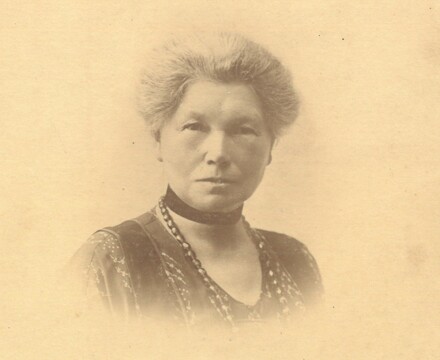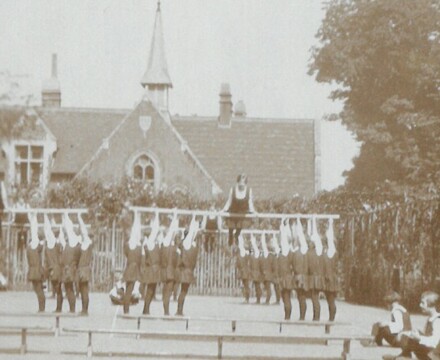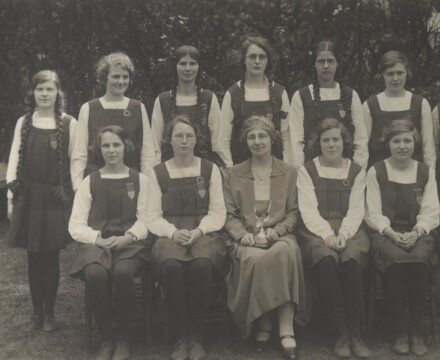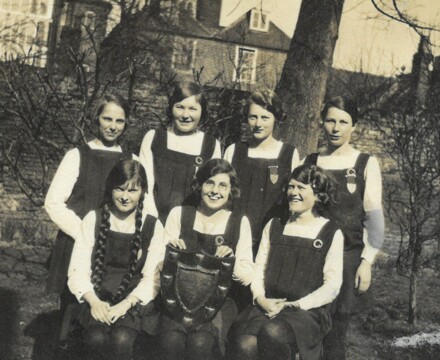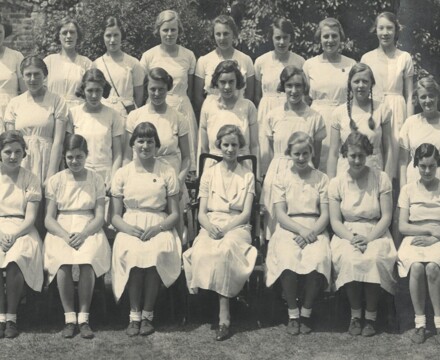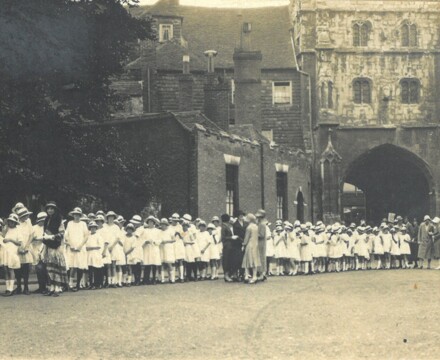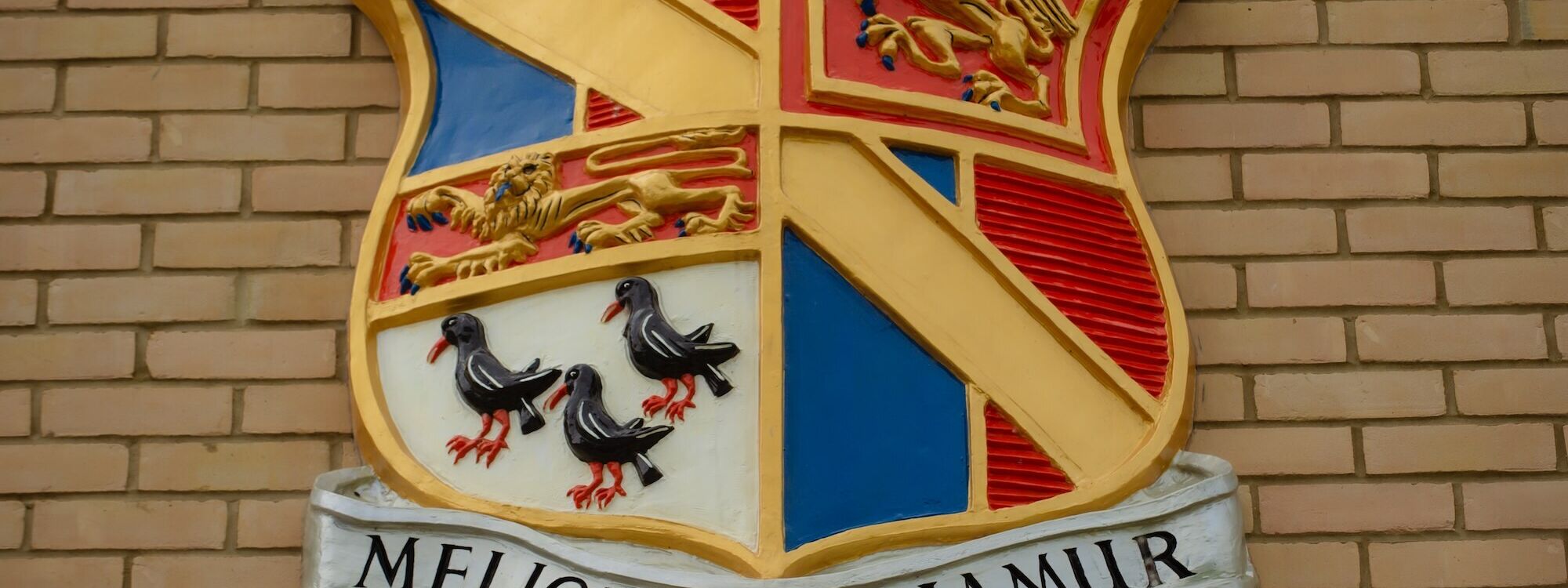
Our History
Mr Senechal, Senior Assistant Headteacher and teacher of history has compiled a detailed and very interesting 'history of the school'.
1248 - 1881
Langton Girls’, a long standing pillar of the community, can trace its 800 year old history to 1248 when Simon Langton, Archdeacon of Canterbury, left provision for the ‘’perfecting’’ of children at the Poor Priests Hospital in Stour Street, then called Hethenman Lane.
In 1373, the wooden buildings in Hethenman Lane were rebuilt in stone, escaped the dissolution during the reign of Henry VIII before they were surrendered to Queen Elizabeth I in 1575 on the understanding that they would be used as a ‘’House of Correction’’ for able – bodied children preparing for apprenticeship.
In 1728, an Act of Parliament of George II transferred the buildings to the ‘’Guardians’’ – the Mayor, Recorder, Justices of the Peace of Canterbury and twenty-eight other persons chosen yearly (two out of each of the fourteen parishes within the City) so that sixteen children could be instructed in ‘’reading, writing and accompts (accounts)’’.
The Endowed Schools Acts of 1869, 1873 and 1874 brought about a crucial meeting in 1876 where the President of the Board of Guardians, Mr Wright of Barton Fields, argued that the Poor Priests Hospital should be used to establish a large school, housed in new premises for the ‘’middle class’’ of the city; clever boys and girls would receive ‘’a good sound English education… suitable for those who would enter a commercial line of life’’.
In 1879, the Poor Priests Hospital was transferred to the Governors of Canterbury’s New Middle Schools and it was hoped that they would provide 125 places for boys and 75 for girls. On 25th March 1879, the Poor Priests Hospital was officially closed following the purchase of a large building, formerly a friary, on the White Friars Estate.
Finally, in 1881, the doors to two schools; Simon Langton Girls’ and Simon Langton Boys’ were opened comprising of two classrooms spanned by open-timbered roofs. The press spoke approvingly of ‘’large and conveniently arranged grounds’’ with children who were ‘’bright and happy and fit for work’’.

The building at Whitefriars - photo taken by Paul Crampton
1881 - 1899
Generally speaking, Victorian parents were unused to the notion that girls had minds worth cultivating and the established view had been that daughters should be educated to be amiable, inoffensive, ‘’always ready to give pleasure’’ and to ‘’get a husband’’.
Miss Sarah Jane Hamm, aged 36, who was appointed as the first Headmistress of Simon Langton Girls’ School (SLGS) in 1881, was different. She strove to offer wider, richer educational opportunities to young women which would include; Scripture, the three Rs, Geography, History, English Grammar, Composition and Literature, Mathematics, Latin, Natural Science, Drawing, Drill, Vocal Music, Domestic Economy and the Laws of Health and French.
The selection of students came next. The girls had to take an entrance examination, both written and viva voce. Their skill in reading, dictation, arithmetic and the geography of England was tested and 61 girls aged between 7 and 16 were selected to start the term of 1881. 4 more girls (Charlotte Robus, Ada Harris, Jane Williams and Lucy Andrews) were awarded scholarships to the sum of £12 per annum for the next three years from which school fees and payment for books were deducted.
Miss Hamm made the first staff appointments including Miss Amelia Proudfoot, a French teacher and future Headmistress of Simon Langton Girls’. Sergeant H Court was appointed to put ‘’his ladies’’ through their physical exercises every Friday afternoon which included the use of dumb bells, ‘’Indian clubs’’ and foils for fencing. He followed P.H. Ling’s Swedish System where the girls would march in step, bending and stretching, swinging clubs in rhythmic, controlled movement ‘’made not only for a healthy body, but a graceful carriage’’.
During their exercises, the girls wore ‘’white canvas shoes over black woollen stockings, heavy navy serge dresses with knickers of the same, collars and belts of pale blue flannel’’. Otherwise they wore ‘’long sleeved dresses, high at the neck and low at the hem, with tuckers of white linen or cambric tacked inside the neck and wristbands’’.
In 1887, SLGS started to take girls from ‘’country areas’’. As transport was negligible, girls from Bridge walked to and from school every day and those that lived in Barham took the ‘’horse-bus’’ and had to allow for a journey of one and a half hours at a time when the bicycle was an expensive luxury. Some parents who lived at a distance boarded their children in houses approved by the Governors on Old Dover Road, Watling Street and St George’s Street.
While some parents and many commentators argued that the discipline of concentrated study and examinations might harm the ‘’delicate constitutions’’ of the girls, Miss Hamm forged ahead regardless. Rose Twyman became the first girl to pass the Junior Cambridge Local Examinations in December 1892, Amy Carter passed at the age of just 12 before taking the Senior Local Examination and winning a scholarship to Girton College Cambridge to read for the Mathematical Tripos, which she passed as a Senior Optime. This encouraged four more girls’ to secure places at Cambridge by 1899; Fanny Bunce, Margaret Shaxby, Mabel Newman and Florence Cole. Meanwhile, Mary Tourtel (née Caldwell) a talented artist at Simon Langton Girls’ School became known to the general public for her creation of Rupert Bear, whose adventures gave so much pleasure to so many children.
For all of the wonderful opportunities that Miss Hamm had provided for the girls during her 8 years at the helm, an illness had crept upon her and she was forced to tender her resignation in 1899. Though she was to die just two years later at the age of 56, Miss Hamm will now live on in our History forever as a woman who broke the mould, just as so many of our girls do today.
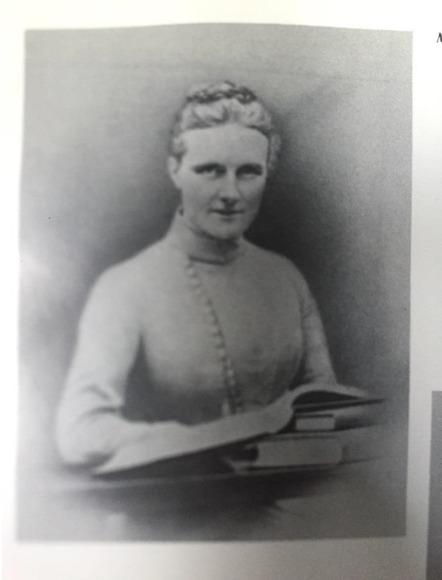
Miss S J Hamm, Simon Langton Girls’ first Headmistress (1881 – 1899)
1899 - 1922
Miss Amelia Henrickson Proudfoot, appointed as Headmistress in 1899 at the age of 26, was to lead Simon Langton Girls’ School (SLGS) for the next twenty-three years. She had been very well educated; she had studied in Paris, gained the Diploma of LLA (a Lady Literate in the Arts) at St Andrews University and she was ‘’a woman of small stature but immense presence’’.
Miss Proudfoot recognised that the new Edwardian era sought to limit girls’ horizons which emphasised the importance of ‘’grace and bearing’’ and ‘’skilfulness of hand, especially in the home arts’’. However, like her predecessor Miss Hamm, she was ambitious for the girls, rewarded those that were loyal to SLGS, increased numbers and access to ‘’physical activities’’, developed the building on the Whitefriars site and oversaw a number of inaugural services and events that still exist today.
During this period, SLGS produced young women who were at the vanguard. The likes of Sydney Horsley kept up the link with Cambridge by winning a place at Newnham in 1907 to read Modern Languages at a time when young women were escorted to lectures in closed carriages by chaperones. Dorothy Taylor headed a list of 4,192 girls in England who took the Oxford (now replacing the Cambridge) Junior Examination and repeated her triumph by outstripping 6,299 candidates in the Senior Examination in 1908. Olive Wells strengthened the link between SLGS and Girton College when she won a place to study Modern Languages in 1922.
The trickle of girls going to college for training as teachers became a stream and were invited to re-join the teaching staff at SLGS. Miss Carter, scholar of Girton College, returned to teach Mathematics. Miss Hinde (who had ‘’a scathing wit’’ and ‘’wore a tailor made costume, shirt and tie’’) returned and was a stalwart of the early century at Langton and kindled a love of History and English and equipped her students with tickets for the Beaney Library. Miss Loth held ‘’musical afternoons’’ and Miss Davison’s operetta ‘’Princess Chrystanemum’’ (which was held where Nasons stood) added to a full star cast of old Langtonians.
By 1922, tennis and netball fixtures were well established. Cricket was popular and had been taken up in preference to archery which had been proposed by Lord Northbourne, a Governor, who subsequently arranged matches between the Cricket XIs of the Girls’ and Boys’ Langtons at his home in Betteshanger. The ‘’navy blue serge gym tunic, with box pleats and velvet yoke, worn with a black braid girdle loosely tied about the hips’’, had become standard uniform by 1922.
In 1902, Prize Distributions were held for the first time which told of the academic achievement and prowess in practical spheres. Commemoration Services had their origin in 1911, when Dean Wace welcomed both Langton Girls’ and Boys’ schools for the first time and when the girls donned white dresses and wore sprigs of ivy. In 1917, Miss Proudfoot introduced the first Prefect System – a first step in self-government on the eve of women’s suffrage.
Numbers of girls, which had reached over 100 by 1902, and 172 by 1905, rose so steeply that, by 1914, SLGS was turning girls away. The pressure of numbers had brought about some expansion so that on 25th October 1906, SLGS included an additional Hall, five classrooms and a Laboratory. While there was no prospect of further building work during the First World War (1914 – 1918), SLGS took in refugees from Belgium when Germany invaded in spite of the fact that Government Inspectors bluntly criticised the overcrowding that they found on their visit in December 1914.
The First World War gave Langton girls the opportunity to leave home and take up war work. Winifred Tice received the Royal Red Cross Decoration ‘’for services with armies in the field’’. Alice Young serving in Malta was similarly decorated. Old girls carried out research in a Government Chemical Laboratory making drawings for shells and served in the Contracts Department of the War Office. At home, the sight of the red flag on the Westgate Towers signalled a day time raid when ‘’Zepplelins hovered over Canterbury for a long time after dusk in August 1915’’ and girls were forced to study by candlelight when electricity was reduced to the merest glimmer.
Under the control and guidance of Miss Proudfoot, she put SLGS ‘’in the front rank of modern Secondary Schools for Girls’’. When she was invited to talk at the Jubilee Speech Day in 1931, she asked that the girls ‘’keep alive the traditions of your school – good work, honest endeavour – and keep pressing forward for something better’’. This is a legacy that has lasted beyond the life of Miss Proudfoot and our school motto ‘’Meliora Sequamur’’ – ‘’let us aim for better things’’ reflects her words and underlines our belief today that we are lifted up and borne aloft by the understanding gained by those that have gone before us.
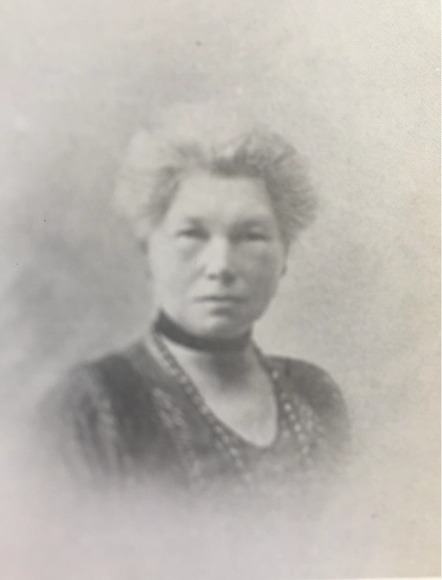
Miss A H Proudfoot, Simon Langton Girls’ second Headmistress (1889 – 1922)
1922 - 1929
The 1920s are often called the ‘’Roaring Twenties’’ – a time of riotous good fun, loud music and wild enjoyment when everyone was having a good time! For those that joined in the party, it was a time of liberation and rebellion against traditional values as all women were given the vote in 1928. More households owned a radio, which gave access to new music as Jazz and the Blues. The newspaper and magazine industries found that sex sold and in a small suburb outside Los Angeles, called Hollywood, a major film industry was developing as Theda Bara and Clara Bow were sold as the ‘’It’’ girls where everybody knew that ‘’It’’ meant sex. Women were said to faint at the sight of male stars like Rudolph Valentino as a half-naked Arab prince in The Sheik (1921). Dances like the Charleston became an obsession among young people. New styles of behaviour were summed up by the image of the flapper; a woman who wore short dresses and make – up and who smoked in public as cars carried boyfriends and girlfriends beyond the moral gaze of their parents.
While this is not how everyone saw this decade, perhaps it is no coincidence that Miss Dorothy Menzies stepped in to the vacancy of Headmistress at SLGS, caused by Miss Proudfoot’s retirement. The competition for the post had been fierce. Miss Menzies, who had attended Camden School for Girls and North London Collegiate (made famous by Miss Buss) and had a Chemistry degree from Royal Holloway, University of London, was chosen from eighty – eight applicants. She was vivacious, approachable and her mantra, ‘’I think girls should be happy’’ boded well for the girls who attended Langton. She was determined that each girl should ‘’develop her own individuality along its own lines, whether artistic, literary, dramatic or athletic’’ and looked to the alliance of the formal curriculum and voluntary activities to achieve it.
Miss Menzies’ interest in the social side of school life brought about the development in clubs and societies. The Natural History Society burgeoned and many Saturday afternoons were spent with Miss Steadman, the Science mistress, collecting shells on The Street at Whitstable, botanizing at Seasalter or inspecting the seashore flora at Sandwich. The Historical Society chronicled the life and times of Fordwich, Harbledown, Richborough and Rochester and was involved in debating, serious research and included talented Drama students presenting scenes for the ‘’Historical Cinematograph’’ (an apparatus for showing film). The Sketch Club* was run by the Miss Twynman whose outstanding talent lay in water colours and the inauguration of a Junior Branch of the League of Nations in 1925 directed girls’ attention to world problems.
Miss Menzies’ interest in social gatherings meant that anticipation of her Christmas parties was ‘’almost as pleasurable as the events themselves’’. It was decided that an ‘’Old Girls’ Association’’ should hold its inaugural meeting in the Sundial Tea Rooms on Great Russell Street in London so that those that had moved out of the Canterbury area could get there easily. Walks, bathing, tennis parties and matinees at the Lyric theatre were the focus of further, regular, weekend reunions. There was care for others outside the Langton community too as a ‘’School Cot’’ was maintained in the Canterbury Hospital by weekly contributions and gifts were sent to the Distressed Miners’ Fund after the strike of 1926.
Miss Menzies’ desire that parents share in the school’s interests and understand her view of education meant that she welcomed them to a growing number of public occasions such as school plays and ‘’parents days’’ which provided an opportunity for all to see demonstration lessons, choral singing, netball, dancing,
gymnastic displays and, for the first time, ‘’Sports Day’’ – instigated in 1924. For the first time, inter-school and inter-form matches were held in a variety of sports including Gymnastics as cups, trophies and badges added to the zest of physical activity. In 1924, Form IVb noted that ‘’An exciting game was introduced to us, called Lacrosse and was the topic of conversation for several weeks’’.
By the time Miss Menzies moved on to her next appointment in 1929, Langton Girls’ School had two hundred and eighty students on roll and the White Friars site had become too small as ‘’classrooms were so packed that it was virtually impossible to pass between the desks’’. She had ‘’won the deep affection of the pupils past and present’’ and had created a community that was as interested in sending its students to higher education as it was in developing the whole person. ‘’The girl who has learned to control her body’’ Miss Menzies said, ‘’to keep her mind fixed upon a definite purpose, to be courteous and reliable in all her dealings, and to be content with nothing less than the best of which she is capable, is the truly educated girl’’.
Thus Miss Menzies legacy lives on in our school today as we also seek to focus on more than academic results. Just as Miss Menzies provided a safe, happy and supportive environment in which to develop and prepare Langton Girls for the challenges and opportunities of today and tomorrow, so we address our community’s comprehensive needs through the shared responsibility of the ‘’Langton Family’’.
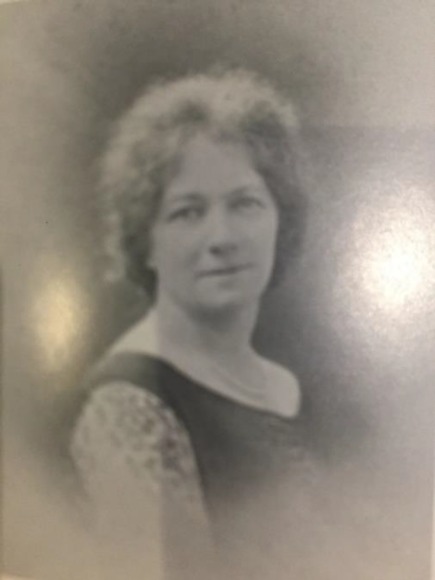
Miss D. Menzies, 1922 – 1929
1929 - 1960
Having graduated with First Class Honours in History and a Masters from Trinity College Dublin, Miss Nora Campling - appointed as Simon Langton Girls’ School’s (SLGS) fourth Headmistress in 1929 - would take up her post in 1930 and stay on for the next 30 years. She was described as ‘’a remarkable, indomitable and gracious Headmistress… who spoke little and worked tremendously hard’’.
During the 1930s, the numbers of students continued to spill over so that classes had to be held in the Headmistresses’ house, Art classes were taught over Eldonne’s dress shop and ‘’Crocodiles’’ had to be escorted over a busy main street to have lunch at Lefevre’s restaurant for there was still no school dining room. No sooner had the Board of Education given Miss Campling its blessing for the purchase of land and property lying between the Old Dover Road and Nackington, however, the Second World War broke out.
When term started in September 1939, Langton girls, carrying their gas masks, found their playground and gardens torn up by the mechanical excavator to provide air raid shelters. Life was comparatively quiet during the months of the ‘’phoney war’’, though after Dunkirk and the fall of France, the air raid alert sent girls scuttling to the shelters and no one left the trenches until the ‘’All Clear’’ went out, even if this meant staying long hours after school.
On 1st July 1940, the first German aircraft crossed the Channel and the air war that became known as the Battle of Britain began. As apples and hops were picked that autumn, an English mistress, Miss Gray, recalled ‘’the familiar drone of aeroplane engines, varied with the staccato rattle of machine guns… [while]… the inevitable Junker or Dornier [was] to be seen somewhere in every walk, lying on the Kentish grass, or among the neglected plums’’.
Langton girls were called-up at the age of 17. The Land Army attracted many, others went into the WRNS, WAAF or ATS, into munitions factories or the AFS. The Civil Service and Local Government offices absorbed a great deal of girl – power and so, too, did nursing. Marian Pine gained the Women’s Land Army County Badge for Courage during the Blitz and Joy Jennings, then in the ATS, was ‘’mentioned in dispatches’’ for ‘’conspicuous devotion to duty’’ when the Tunisian campaign was being mounted.
The City, shaken by sporadic bombs and anticipating an invasion, became an evacuation area in September 1940 and, with less than 36 hours notice, Mary Carlton, a Sixth Former, remembers, ‘’while sirens wailed and windows shook, arrangements were made for the school to go – no one knew where at first…’’ She reported that, ‘’on the morning of 12th September we assembled, with other Canterbury children, at the West Station, complete with gas masks, ration books, identity cards, one small suitcase and food… I was put in charge of a compartment of unknown girls and young siblings… At about 1:30pm the train arrived at Reading. All the children were taken to the Church Hall and then to the billets’’. Unbeknownst to Mary Carlton, it was thanks to Miss Campling’s swift and unheralded action that Langton girls were transported safely to Abbey School in Reading, for she knew the Headmistress there and had made arrangements to take them to safety.
During the winter of 1940, while Langton girls were warmly invited and integrated at the Abbey School, Miss Campling laboured in dust and discomfort to reinforce downstairs classroom. Under her auspices, she ensured that the Langton Boys’ and Girls’ Schools pooled resources so that she could get her girls back home. With the boys’ 13 rooms it was possible to work a shift system for the rest of term whereby the boys and girls each had 4 hours of schooling every day.
If anything, the intensification of the Blitz in 1941 – 42 in the so-called Baedeker raids (the targets were chosen by the Germans from the Baedecker tourist guide book) increased Miss Campling’s determination to resist. On 1st June 1942 or ‘’Flaming June’’ as Miss Gray called it, ‘’old landmarks were no more, and the ancient City of Canterbury… was in considerable part destroyed by bombing. There were tales that ‘’the Langton had gone’’, but ‘’6 classrooms remained to the girls, though furniture, books equipment, precious examination notebooks were left smouldering still’’. From the desolation of the playground it was possible to look across the rubble and have an uninterrupted view of the South side of the Cathedral.
In spite of the heavy, brotherly, jokes that were made by Langton boys, Miss Campling found a new, temporary, home for the girls in the empty and bomb damaged Mental Hospital up St Martin’s Hill (where the Day Hospital now stands). She was even able to take in refugees including Eva Cohn who had fled Nazi Germany and was eventually reunited with her father in the USA.
Miss Campling made the building habitable, and, in October 1942, ‘’the citizens of Canterbury saw a long line of girls leave White Friars and walk up the High Street, along Longport, and up St Martin’s Hill to their new school at Stone House’’. Furniture, gleaned from surrounding schools and equipment that had survived the Blitz was installed and, though the heating was temperamental and torrential rain caused flooding, when summer came there were few who did not revel in the spacious rooms and the beauty of the grounds.
The strength and will and purpose shown by Miss Campling brought the school through the dangers, uncertainties and changing circumstances of the war and with satisfaction Miss Campling recorded that 1944 was ‘’a year of quiet progress’’. Miss Campling’s intention was not deflected by a serious illness in 1945 when she stuck vigorously to the task of reconstruction and recovery. It was said that whenever Miss Campling was with the girls, the Germans would not dare to bomb the buildings and spirits were buoyed at the end of the war by thoughts of ‘’the new school’’.
The new site was already graced by the Pavilion, (completed and opened in grand style by Sir Charles Collett on 1st May 1936) and, ‘’where Mr Hambrook’s bullocks once grazed’’, drains were laid, foundations dug, and the skeleton of one wing was visible by 1948. The architect of this new building was Mr Hugh Wilson – later to receive a knighthood. He constructed it of concrete and glass and those that were used to the ‘’cold, damp and darkness’’ of Stone House revelled in ‘’the light and sunshine’’ which pervaded it.
For the second time in a decade, the Langton girls migrated to another home, and started school on 14th September 1950. On 6th February 1951, the Archbishop of Canterbury opened the building officially and dedicated it. The Mayor and Mayoress of Canterbury, both of whom were old Langtonians, toured the ‘’show school’’ along with other dignitaries. Furniture, equipment, pictures and books turned a structure in to a habitation. The Hall was enriched by a platform. A great table and five chairs were made out of a combination of woods, including Honduras mahogany with Macassar ebony and sycamore. With a gift sent from America by Mr Daniel Cohn, Eva’s father, Miss Campling bought 3 pictures by Van Gogh to hang in the Entrance Hall as well as a Monet and a Renoir.
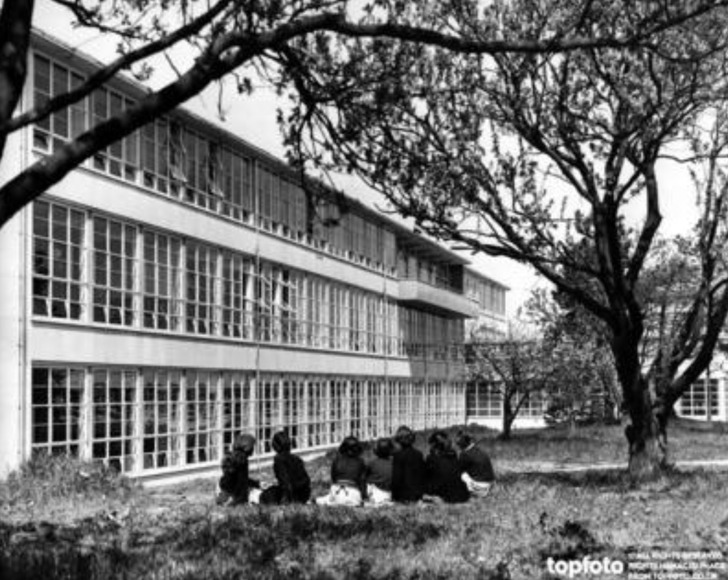
A group of pupils sitting in the sunshine under trees and a view the many windows of the new school 4th June 1951
It had always been Miss Campling’s ambition to raise the intellectual standard of the school still further and, as a Secondary Grammar School under the 1944 Education Act, the Girls’ Langton would, once again, be at the vanguard. In 1950, the Headmistress reported with satisfaction that there had been 100% passes as girls went from every Department to read for degrees during that decade. 1952 was a vintage year; the school claimed nine State Scholarships, two Open Scholarships at colleges of London University, two entrances to Oxford, two to Cambridge, while Anne Pennington won a Major Scholarship in Modern Languages at Newnham and an Open Scholarship at Lady Margaret Hall at a time when the proportion of places available to women at Oxford and Cambridge was limited by the University Statute to 10% - a restriction which lasted until 1974. The less gifted brother might gain a place where his more talented sister was rejected.
Girls were streamed and setted according to ability and when they were about 16 they entered the Arts, Science or Subsiduary Sixth Forms. Thus a broad varied curriculum was devised for those who did not want strictly academic courses. This included, if required, two and a half days spent at the Girls’ Technical School (precursor of Barton Court) to learn commerce and book keeping. Opportunities for exercise and a gymnasium and 13 acres of playing fields were firmly grasped. Hockey was introduced in 1952 where Langton girls were subsequently chosen to play for Kent Schools. By 1960, Langton tennis teams competed for the Aberdare and Ames Cup.
By the time she retired in 1960, Miss Campling had established uncommonly high standards of conduct and learning. Miss Campling died in May 1962 and she was not, after all, able to develop her ‘’zest for new experience’’ to travel abroad. However, Miss Campling’s single minded purpose had driven her on to overcome the anxieties and complexities of World War Two, ensure that SLGS emerged from peacetime in enlightened, spacious, buildings on their new site on the Old Dover Road as she oversaw Langton’s transformation in to a ‘’Grammar’’ – all achieved through dedicated hard work.
She was a formidable war time leader of the Langton Girls’.
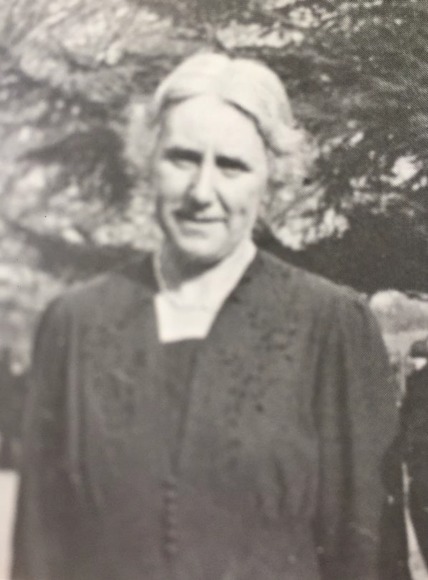
Miss N Campling, 1930 – 1960
1960 - 1974
Our School Crest
Looking back, looking forward…
The symbol of Langton Girls’ Grammar encapsulates tradition and modernity. On the one hand, a pillar of the educational community with a long history of sending students to the best universities, institutes and employers worldwide. On the other, a forward thinking, innovative school which is at the forefront of change and progress.
The school’s coat of arms shows the heraldic lion which denotes Canterbury’s links to royalty and symbolises courage, leadership and ferocity under provocation. The griffin is a legendary creature with the body of a lion and the head and wings of an eagle. Only a female griffin has wings and is usually shown rearing up, facing left, and standing on one hind leg with the other leg and the claws raised; this posture is described as ‘’segreant’’, a word uniquely applied to griffins and is the exact equivalent of the description of lions and other creatures in heraldry as ‘’rampant’’. As protectors from evil and a guardians of the light, the griffin represents ‘’wisdom joined to fortitude, but wisdom should lead and fortitude follow’’.
The three choughs, birds of the crow family, were taken from the coat of arms of Thomas Becket, the Archbishop and martyr whose shrine in Canterbury Cathedral was a place of pilgrimage in the Middle Ages. It was said that a crow did stray into the Cathedral and peck about in the sanguine chaos, staining its legs and beak, which provides its distinctive colouring. While crows are often associated with sadness or grief, they symbolise spiritual and emotional transformation as they are watchful, intelligent creatures who are said to be gifted with foresight.
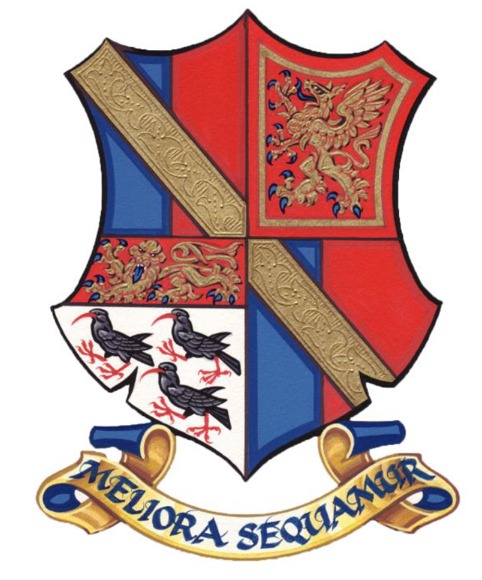
Langton Girls’ Grammar’s school motto, ‘’Meliora Sequamur’’ (Let us aim for better things) underlines the belief that we are lifted up and borne aloft by the understanding gained by those who have gone before us. Previous Headmistresses and students at Langton have embraced schemes for branching out in to new frontiers, celebrated individualism and ensured that Langton continues to be at the vanguard.
